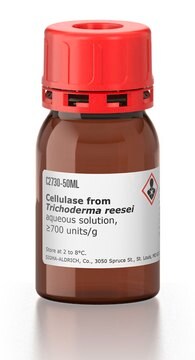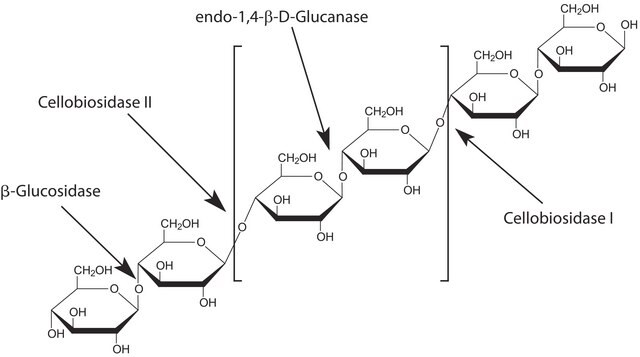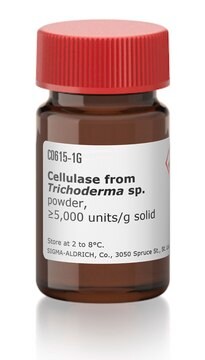C9499
Cellulase, thermostable from Clostridium thermocellum
recombinant, expressed in E. coli, ≥90% (SDS-PAGE)
Synonyme(s) :
1,4-(1,3:1,4)-β-D-Glucan 4-glucano-hydrolase
Se connecterpour consulter vos tarifs contractuels et ceux de votre entreprise/organisme
About This Item
Numéro CAS:
Numéro MDL:
Code UNSPSC :
12352204
Produits recommandés
Produit recombinant
expressed in E. coli
Niveau de qualité
Pureté
≥90% (SDS-PAGE)
Forme
liquid
Activité spécifique
≥40 units/mg protein
Poids mol.
41 kDa
Concentration
19-21 mg protein/mL (UV)
Conditions d'expédition
wet ice
Température de stockage
2-8°C
Application
Cellulases are enzymes that hydrolyze cellulose to glucose. Cellulase is used to study the development of occupational asthma in the detergent, pharmaceutical, baking, and enzyme production industries . Cellulase is added to detergents to improve cleansing properties . Cellulase, product C9499, is from Clostridium thermocellum and is recombinant and expressed in E. coli.
Actions biochimiques/physiologiques
Cellulases are produced by the intestinal flagellates of termites which are important for cellulose digestion of their host termites . Cellulases have different microbial origins and therefore different protein sequences . Product C9499 exhibits endo-cellulase, β-glucanase activity when assayed using insoluble AZCL-linked substrates as well as exo-cellulase and cellobiohydralase activities.
Définition de l'unité
One unit will produce 1 μmole of reducing sugar (measured as glucose) from β-glucan per minute at pH 5.8 at 70 °C.
Forme physique
Supplied as as solution in 50 mM Tris-HCl, pH 7.5, 100 mM NaCl, and 25% glycerol.
Code de la classe de stockage
10 - Combustible liquids
Classe de danger pour l'eau (WGK)
WGK 2
Point d'éclair (°F)
Not applicable
Point d'éclair (°C)
Not applicable
Certificats d'analyse (COA)
Recherchez un Certificats d'analyse (COA) en saisissant le numéro de lot du produit. Les numéros de lot figurent sur l'étiquette du produit après les mots "Lot" ou "Batch".
Déjà en possession de ce produit ?
Retrouvez la documentation relative aux produits que vous avez récemment achetés dans la Bibliothèque de documents.
Gaku Tokuda et al.
Biology letters, 3(3), 336-339 (2007-03-22)
The intestinal flagellates of termites produce cellulases that contribute to cellulose digestion of their host termites. However, 75% of all termite species do not harbour the cellulolytic flagellates; the endogenous cellulase secreted from the midgut tissue has been considered a
A Brant et al.
Occupational and environmental medicine, 61(9), 793-795 (2004-08-20)
Three employees from two different detergent companies were investigated for occupational asthma, using skin prick tests, serum specific IgE, and specific bronchial challenge. Two were challenged with lipase and one with cellulase. All three cases had immunological evidence of sensitisation
Qiuhong Niu et al.
Wei sheng wu xue bao = Acta microbiologica Sinica, 52(11), 1408-1414 (2013-02-07)
To screen, identify bacterial strains with high capability to degrade cellulose from bacteria associated with Bursaphelenchus xylophilus and to clone related genes. First, we collected B. xylophilus samples from pine wood nematode disease areas in Nanyang, Henan province, China. Then
Yohei Yamakawa et al.
Biochemical and biophysical research communications, 431(4), 777-782 (2013-01-23)
Cellobiose triggers the production of two endoglucanases, EglA and EglB, in Aspergillus nidulans. The cellulose responsive element (CeRE) cis-element that is essential for induction has been identified on the eglA promoter, but transcription factors that bind to CeRE have not
Tomonori Nakai et al.
Journal of bacteriology, 195(5), 958-964 (2012-12-18)
Cellulases are enzymes that normally digest cellulose; however, some are known to play essential roles in cellulose biosynthesis. Although some endogenous cellulases of plants and cellulose-producing bacteria are reportedly involved in cellulose production, their functions in cellulose production are unknown.
Notre équipe de scientifiques dispose d'une expérience dans tous les secteurs de la recherche, notamment en sciences de la vie, science des matériaux, synthèse chimique, chromatographie, analyse et dans de nombreux autres domaines..
Contacter notre Service technique






